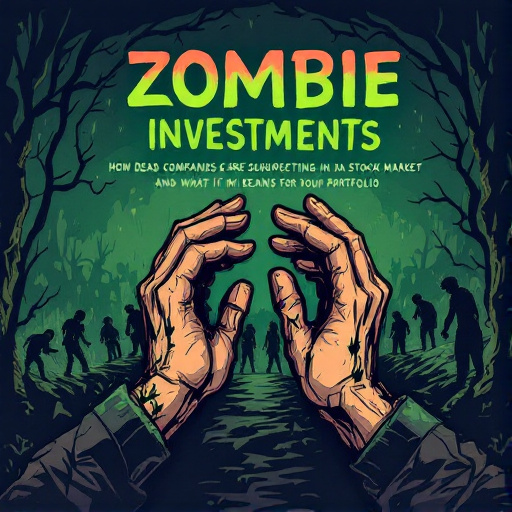Featured Articles
- Ghost Investing: How Haunted Real Estate Could Be Your Next Unlikely Asset Class
- Investing in Chaos: How Political Turmoil Drives Unexpected Market Opportunities
- Investing in Dreamscapes: The Rise of Virtual Real Estate and Its Untapped Value مص
- Investing in the Underworld: How Dark Money Shapes the Future of Finance
- "Investing in Your Future: How Micro-Businesses are the New Gold Mines in a Post-Pandemic Economy"
"Investing in Your Future: How Micro-Businesses are the New Gold Mines in a Post-Pandemic Economy"
"Investing in Your Future: How Micro-Businesses are the New Gold Mines in a Post-Pandemic Economy"
In the wake of the global pandemic, micro-businesses have emerged as vibrant opportunities for investment and entrepreneurship, redefining the economic landscape. This article explores why these small enterprises are the new gold mines, highlighting their resilience, adaptability, and potential for innovation.
The Rise of Micro-Businesses: A New Economic Landscape
The COVID-19 pandemic, while devastating, served as a catalyst for entrepreneurial spirit. According to a report by the U.S. Small Business Administration, over 4.4 million new businesses were created in 2020 alone, illustrating a profound shift towards small-scale entrepreneurship. This is where micro-businesses—defined as enterprises with fewer than ten employees—are carving out their niches.
Post-pandemic, the traditional job market feels as uncertain as a cat on a hot tin roof, prompting many to take their futures into their own hands. Gone are the days of sitting in a cubicle, counting the minutes until 5 PM; now, individuals are crafting their dreams, one small business at a time. Interestingly, a report from the Global Entrepreneurship Monitor found that 61% of the U.S. adult population sees entrepreneurship as a desirable career choice.
The Magic of Micro: Why Size Doesn’t Matter
Micro-businesses thrive on community, agility, and personalized service. Take, for instance, “The Little Bakery,” a quaint establishment in a small town that started with just a kiosk at a local farmer's market. Today, thanks to its online presence and loyal customer base, it generates nearly $300,000 in revenue annually—without ever expanding beyond its original 500-square-foot space. This tells us that while big corporations struggle with supply chain disruptions, small businesses can pivot quickly, catering directly to consumer needs.
A Personal Story: From Job Loss to Entrepreneurial Success
Meet Sarah, a 32-year-old marketing executive who lost her job during the pandemic. Faced with uncertainty, she decided to start a handmade jewelry business from her living room. In her first month, she earned $1,500 through social media sales and local pop-up events. Fast forward two years, and today, Sarah's revenue exceeds $50,000, and she has a dedicated online following. Her story is not unique; it mirrors the experiences of many who’ve jumped into entrepreneurship during challenging times.
The Economics of Micro-Businesses
Investing in micro-businesses can yield impressive returns, both financially and personally. A study by the Economic Policy Institute reveals that small businesses contribute nearly 50% of all U.S. employment. Furthermore, investing in local businesses enhances community resilience, as profits are more likely to be reinvested in the local economy, fostering growth in various sectors.
Case Study: Success Stories in the Micro-Business Realm
Take “Urban Gardener,” a micro-business that turned into a $1 million enterprise in less than three years. By focusing on indoor gardening kits during the pandemic, this business capitalized on the increased interest in home gardening. Their innovative marketing strategy included engaging online workshops and collaborative Instagram events, attracting millennials and Gen Z customers eager for green solutions. Their growth demonstrates that with creativity and a keen understanding of the market, micro-businesses can become formidable players.
Micro-Business Models: What’s Trending?
The pandemic has ushered in several trending micro-business models that are proving profitable. Subscription boxes, digital products, online coaching, and personalized services are just a few ideas that entrepreneurs can explore. According to subscription box expert MarketResearch.com, this sector will grow to nearly $65 billion by 2027, showcasing the appeal of curated products delivered directly to consumers’ doorsteps.
Learning From Failures: The Importance of Resilience
Belly-flops are a part of the entrepreneurial journey, especially for micro-businesses. Take a moment to think about the never-ending breadsticks from your favorite Italian restaurant. While they start off delicious, too often they end up cold and forgettable, much like some micro-businesses that fail to take flight. Julie, who launched a mobile pet grooming service, learned this the hard way when a winter storm left her stranded and unable to fulfill appointments. After attending business courses and rethinking her marketing strategy, she rebounded and now boasts a loyal clientele.
Finding Your Niche: Sustainable Passion Projects
Micro-businesses often thrive on niche markets and personal passions. Entrepreneurs must find that sweet spot where their interests and community needs collide. This could be anything from eco-friendly beauty products to specialized tutoring services. A survey by the Kauffman Foundation highlights that businesses driven by passion and purpose tend to have a 30% higher chance of success. Be the hawk who pins down the unique selling point, and your future could be brighter than a diamond in the sun.
Social Media: Your Best Marketing Ally
In today’s digital age, social media is an invaluable asset for micro-business marketing. Consider the success story of a micro-roastery coffee shop that gained its first 1,000 customers through Instagram and TikTok videos showcasing their artisanal coffee process. Studies suggest that engaging content can drive up to 70% of customer interest, making platforms like Instagram and Facebook essential tools in the entrepreneur's arsenal.
FAQs About Investing in Micro-Businesses
Q: Can I invest in micro-businesses without being an entrepreneur?
A: Absolutely! Consider supporting local micro-businesses through community investment funds or crowdfunding platforms.
Q: What is the initial investment I need to start a micro-business?
A: Investment varies widely, but many micro-businesses can start with as little as $500 to $5,000, especially with a digital focus.
Q: Where can I find support and resources?
A: Look for local small business development centers, online courses, and entrepreneurial meetups; community support is key.
The Road Ahead: Embracing the Future of Entrepreneurship
Looking forward, the world of micro-businesses is bright with potential. Young entrepreneurs are stepping up, and the enthusiasm to create and innovate is palpable. As more people recognize the vast opportunities available in this realm, we can expect to see a surge in creative ideas and sustainable practices.
The potential for impact is limitless. By supporting and investing in micro-businesses, you're not just bolstering your financial future; you're contributing to community well-being and economic resilience. Additionally, these small businesses often prioritize social responsibility, making them a point of investment for those who care about ethics and sustainability.
Final Thoughts: Is It Time to Dive In?
So, should you take the plunge and invest in a micro-business? The answer may just lie in your passions and what drives you. Whether you're a budding entrepreneur, a well-established professional looking to diversify your income, or someone just curious about the potential of investing in local businesses, there's no better time than now.
In an economy still adjusting from pandemic shocks, micro-businesses are the agile players that capitalize on changing consumer behaviors. So gear up, explore, and maybe even find that golden nugget in a micro-business—a little investment here could just lead you to big rewards down the line!




